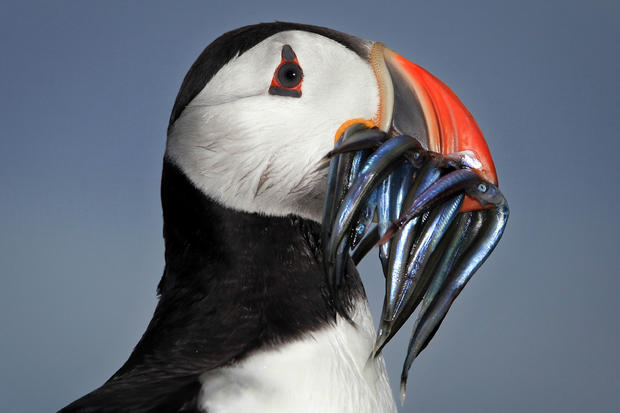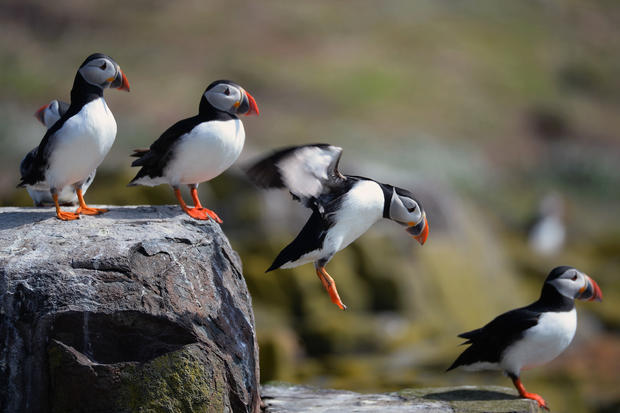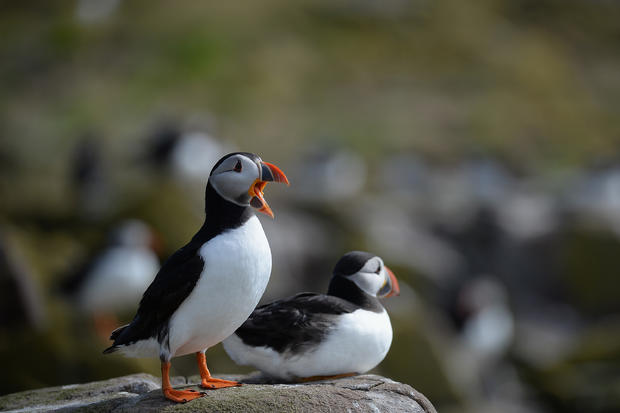Atlantic Puffins In Peril In U.S.
PORTLAND, Maine (AP) — The Atlantic puffin population is at risk in the United States, and there are signs the seabirds are in distress in other parts of the world.
In the Gulf of Maine, the comical-looking seabirds have been dying of starvation and losing body weight, possibly because of shifting fish populations as ocean temperatures rise, according to scientists.
The survival rates of fledglings on Maine's two largest puffin colonies plunged last summer, and puffins are in declining health at the largest puffin colony in the Gulf, on a Canadian island about 10 miles off eastern Maine. Dozens of emaciated birds were found washed ashore in Massachusetts and Bermuda this past winter, likely victims of starvation.
Whether dead puffins will continue washing up on shore and puffin chick survival rates will stay low remains to be seen. But there are enough signals suggesting that puffins and other seabirds could be in trouble, said Rebecca Holberton, a professor at the University of Maine who has studied puffins for years.
"It's our marine canary in a coal mine, if you will," she said.
The situation has drawn the attention of scientists at the National Oceanic and Atmospheric Administration's Northeast Fisheries Science Center in Woods Hole, Mass., who are looking at how shifting fish populations can affect the productivity of puffins, as well as Arctic terns.
With its colorful striped beak, pear-shaped body and amusing waddle, the Atlantic puffin is sometimes called the clown of the sea. It's also held up as a poster child for successful seabird restoration.
An estimated 6 to 8 million puffins live across the North Atlantic, from Maine to northern Russia. But they almost disappeared from Maine after settlers hunted them in the late 1800s for food, eggs and feathers. By 1901, only one pair of puffins nested in Maine, on remote Matinicus Rock.
Steve Kress, director of the National Audubon Society's seabird restoration program, has worked to restore and maintain the puffin population off the Maine coast for the past 40 years. Puffins spend most of their lives at sea, coming ashore only to breed each spring before returning to the ocean in August. The chicks swim to sea about 40 days after hatching and typically return to the islands after two years.
More than 2,000 of the birds are now in Maine, the vast majority on three islands. But the chick survival rates on the two largest colonies took a dive last summer, possibly because of a lack of herring, their primary food source, Kress said.
On Seal Island, a national wildlife refuge 20 miles offshore that's home to about 1,000 puffins, only 31 percent of the laid eggs produced fledglings, down from the five-year average of 77 percent. Similar numbers were experienced at Matinicus Rock, a nearby island with more than 800 birds.
Instead of feeding their young primarily herring, puffin parents were giving them large numbers of butterfish, a more southerly fish that's becoming more abundant in the Gulf or perhaps more accessible to seabirds because they've moved higher up in the water column. But the chicks ended up starving to death because the butterfish were too big and round for them to swallow, Kress said. Piles of uneaten butterfish were found next to some of the dead birds.
Kress thinks the upward trend in Gulf of Maine water temperatures could be to blame, with last year's record readings causing butterfish to grow faster earlier in the season because of an early phytoplankton bloom, upon which they feed. With a low survival rate, unexplained die-offs and extreme ocean conditions washing away puffin burrows on Seal Island — something he's never seen before — Kress is concerned about what future years will bring.
The puffins in the Gulf of Maine are particularly vulnerable because they live on the outer edge of the bird's geographic range. Moreover, there are signs of distress elsewhere — die-offs in the North Sea and population declines in Iceland, home to more than half the world puffin population, and other places — that have raised fears that extreme weather and warmer ocean waters brought about by climate change may be affecting the birds.
"We don't know how the puffin will adapt to these changes — or if they'll adapt to these conditions," Kress said.
The Gulf of Maine's largest puffin colony — with more than 10,000 birds — is found on Machias Seal Island on the Maine-Canada border 10 miles off the eastern Maine coast. There, the average body weight of both adult and baby puffins has been on the decline, most likely because of a shortage of food, said Tony Diamond, a University of New Brunswick professor who studies puffins on Machias Seal. The amount of herring in the puffin's diet has been falling by about 5 percent a year, he said.
What's more, puffins on Machias Seal are breeding later this year than any time on record, another sign of stress, Diamond said.
Another big concern is the unprecedented puffin die-offs this past winter. More than 2,500 dead puffins were found washed ashore in Scotland, and about 40 of the birds (along with hundreds of razorbills) were found on the Massachusetts shore. More dead puffins were found in Bermuda.
For every bird found dead, there are probably tens or hundreds more that died and didn't wash ashore, scientists agree.
"That's a large number of birds for the Gulf of Maine," Kress said. "We don't have that many birds to spare."
Necropsies on the Cape Cod birds indicated they starved, said Julie Ellis, project director for The Seabird Ecological Assessment Network at Tufts University.
Diamond has seen other seabird colonies virtually vanish overnight. Machias Seal Island used to have more than 3,000 terns, the largest such colony in the Gulf of Maine. But since 2007, only small numbers have come back each summer, and those that have returned haven't been able to breed, Diamond said.
Nobody knows what the future holds for puffins, but anything's possible, he said.
"In the Gulf of Maine, we're on the southern end of the bird's range. It looks like the range might be set to contract northward," Diamond said.
Kress is hopeful the Gulf population will sustain itself. But he's concerned about what he's seeing.
"You never know what climate change will bring," he said. "Historic fish could move out and more southerly fish could move in, and puffins may adapt to the new fish. Only they will know how the story will unfold."
(TM and © Copyright 2013 The Associated Press. All Rights Reserved. This material may not be published, broadcast, rewritten or redistributed.)








